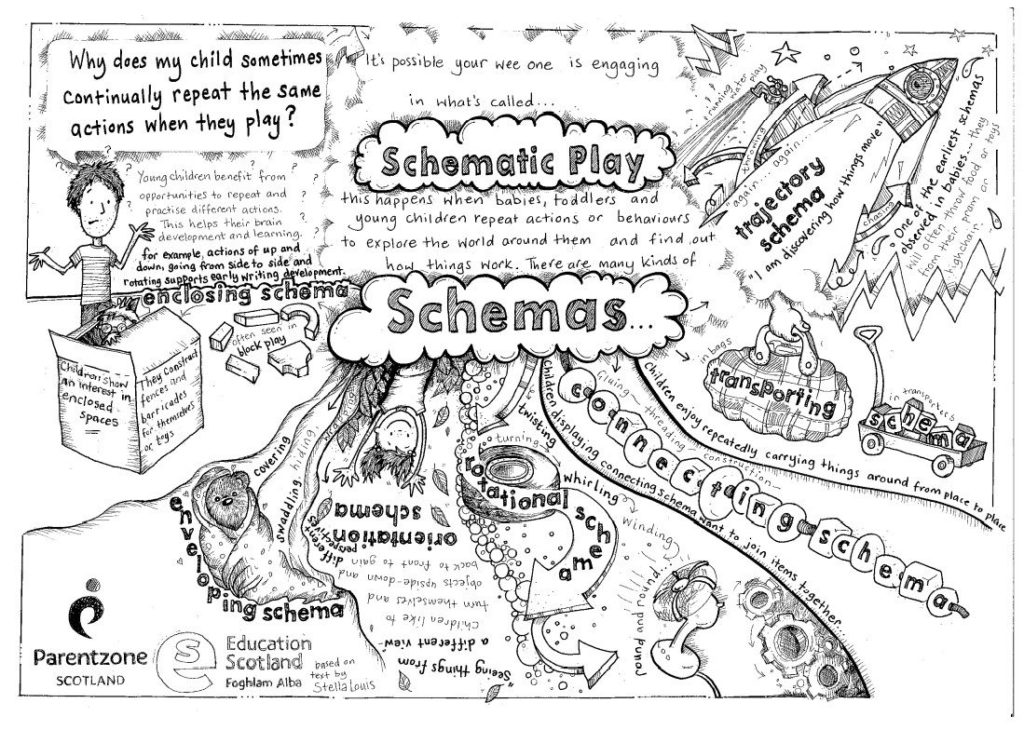Schemas
Resources
What are they?
Schematic play is when children repeat patterns of  behaviour or actions when they explore the world and how things work. There are many examples of schematic play including, trajectory, enveloping, enclosing, connecting, and orientation.
behaviour or actions when they explore the world and how things work. There are many examples of schematic play including, trajectory, enveloping, enclosing, connecting, and orientation.
Not all children will engage in schematic play; however, it is observable across multiple play situations. When a child is involved in schematic play, they are fully involved, and a high level of learning occurs. This requires adults to observe what is happening and not impose their ideas or thinking on the child, but instead let the child explore and follow their interest, providing additional resources or materials as appropriate.
Nutbrown (cited as, Realising the Ambition, Education Scotland, 2020) suggests that when children connect schemas, they develop higher-order thinking through refining and consolidating learning.
“Schema is a repeated pattern of behaviour in their play that young children express through their ideas and thoughts as they explore the world and try to make sense of how things work. As children grow, these schemas increase in number and become more complex.”
(How good is our early learning and childcare?, Education Scotland, 2016, p. 51)
Key messages:
- Well-trained practitioners who understand schematic play and the importance of its role in child development.
- Responsive adults who observe, identify schemas and support the child’s schematic play.
- Children are given time to creatively explore and choose what they play with, developing ownership, independence and problem-solving.
- Spaces and experiences that support the child’s schematic play and learning.
- Share information with parents regarding schemas and how to support at home.
Ways we can do this:
Ensure that the practitioners working with young children understand and take part in training about schematic play.
Practitioners carefully observe children playing, identify schematic play, and use this information to support observations and inform planning.
Provide plentiful opportunities for schematic play by introducing additional materials and resources across play areas; for example, if the child engages in the rotational schema by turning on and off taps, introducing wheels or tyres for them to move around can extend this area of interest. Both responsive and intentional planning is part of this process.
Plan to include a variety of resources to support this type of play, both indoors and out. Where appropriate, planning documentation should reflect how adults are supporting schematic play (making learning visible).
Develop a high-quality learning environment that is exciting and challenging, that provides multiple ways for schemas to be investigated.
Include toys and open-ended resources that provoke thinking, creativity and problem-solving.
It is essential to share information about schemas with parents and carers to offer them ideas of supporting their children’s development at home in ways that link into the schemas they are interested in. Sharing information about schemas helps parents and carers recognise and identify schemas and play patterns, reassuring them that schemas are a common way that children can learn and develop.
Linked Areas of Practice
Child Development
Early Learning & Childcare for 2 year olds (ELC 2)
Loose Parts
Nurture
Observations
Play
Sensitive Interactions
Spaces
Tools
Reflecting on Practice
SBC Guidance to support
National Guidance to support
Further Reading to support
Training to support
